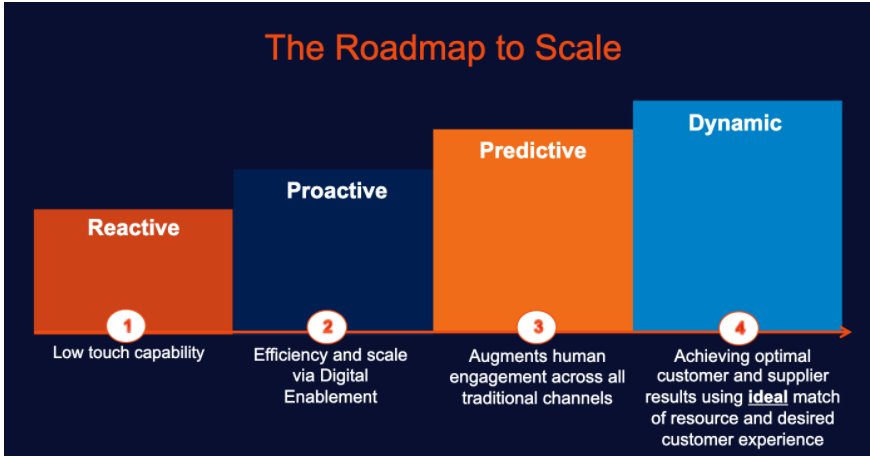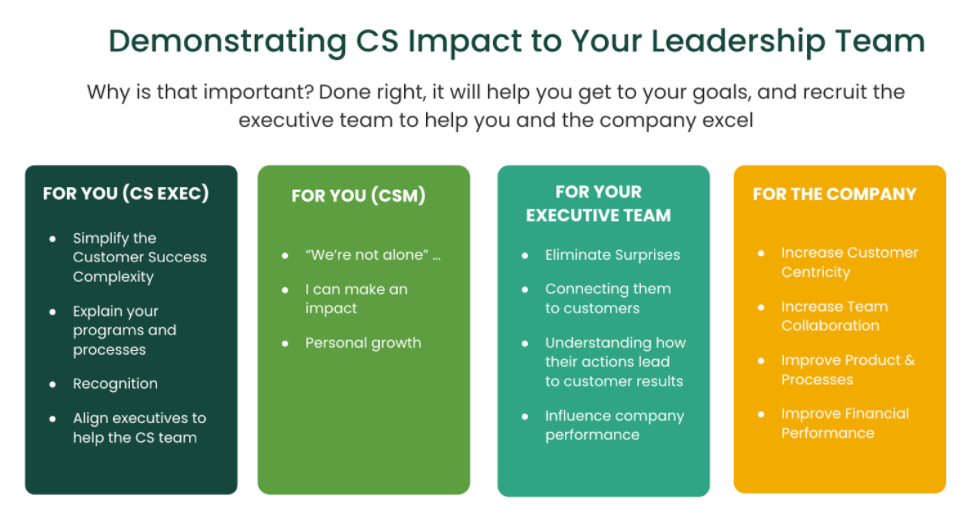Ongoing market volatility created by the COVID-19 pandemic has placed a greater emphasis on the revenue potential of existing customers. A decline in new business opportunities brought about by belt-tightening in the market is encouraging the use of Customer Success best practices to retain and grow opportunities with existing customers. By delivering value to customers, generating business outcomes, and creating loyalty, companies are driving growth through customer retention and expansion, despite the pandemic.
In uncertain times, however, it is difficult to predict customer behavior or anticipate future needs. The critical ingredient in the quest for enterprise growth, therefore, becomes customer visibility.
Making customers feel seen and heard is critical to building positive relationships with them and creating life-long customers. By making customer data accessible, accurate, and comprehensive, Customer Success technology creates a customer 360 view, which, in turn, makes it easier to strategize and take action to increase customer engagement, satisfaction, and retention.
Customer Success Challenges
A Totango survey of business professionals found that Customer Success, and the customer-centric approach to service, is now a regular and popular practice for many companies. Specifically, the survey found:
- 80% of respondents say their CS team grew over the past 12 months.
- More than half of CS teams now consist of more than 10 members, a 6% increase.
- 44% of respondents said their CS team was responsible for revenue targets.
- The average respondent planned to increase their CS investment by 10% in 2020.
The rising awareness of the importance of customer-focused solutions is also reflected in the top pain points described in the survey:
- Visibility into customer adoption and health
- A reactive approach to customers
- Organizational alignment
- Prioritization and focus of tasks
- Scaling the team
- Executive support
These results suggest that Customer Success technology is going to play an increasingly critical role in providing solutions to customer visibility challenges.
Customer Success Technology as a Solution
Increased customer visibility exposes the current customer experience and provides your organization with the opportunity to create proactive engagements that are timely, relevant, and effective. Every customer is on a journey, and data-driven engagements keep them on the path to rapid, recurring value. Most of these challenges can be mitigated by using Customer Success technology to collect and analyze customer data and use the findings to create goal-based, results-driven processes.
1. Visibility into Customer Adoption and Health
You can empower your organization to make data-driven decisions by gathering, organizing, and analyzing the right customer information and democratizing the data for the rest of your organization to use. Customer information, sales team data, product usage, support tickets, escalations, surveys, NPS data, and personal interactions are all invaluable information for your team to track and take action on. Information from all of these sources can be combined with proven customer success algorithms to produce a living customer health score that offers a holistic view of where your customers are at, ensuring no employee remains in the dark on a customer’s progress. A real-time customer health score can help you with automating team playbooks to drive higher levels of customer engagement and identify at-risk customers so that you can kick-start your recovery plan. These are just a few examples of where a customer health score can help you with delivering business outcomes.
| SAP’s Success Story
As a rapidly growing global enterprise application software company with thousands of customers, business partners, and employees all over the world, SAP quickly realized the complex needs of both their business and their customers required a comprehensive system to centralize and disperse customer data. With the help of a Customer Success technology partner, 11,000+ SAP users are now able to monitor customer adoption and health, drive business alignment, and improve customer experiences by tracking critical customer information to make data-driven decisions. |
2. A Reactive Approach to Customers

Credit: Phil Nanus, VP of Customer Success Research at TSIA. From the presentation on The Next Level of Scaling Customer Success.
Companies are beginning to see the disadvantages of a reactive customer success approach—basing strategic decisions off of outdated data, being late to renewal conversations, and having an unclear forecasting view. Instead, companies are embracing a more mature model of customer success—the dynamic engagement model. Since the dynamic engagement model is the new industry standard, if your company does not already have a predictive model of customer success in place, the gap of what your company is capable of is only going to widen.
Consider using a Customer Success platform to adopt a more dynamic approach to do the following:
- Optimize and align digital and human resources
- Identify trends and build proactive engagement strategies
- Empower cross-departmental participation in customer success
- Cost-effectively deliver value
- Increase retention by providing customers with the right resource at the right point in their journey
By partnering with a Customer Success technology partner, companies saw the following results:
- SAP experienced 6 times the regular amount of customer engagement in the first 30 days of having new customers
- Zoom saw a 65% increase in customer health
- TrustPilot retention went from 72% to 95%
Adopting a customer-centric approach to customer success drives results. The key is using customer data to trigger direct, impactful customer engagement at scale.
3. Organizational Alignment
Customer information is the backbone of your customer success efforts. It will help you turn broad goals into actionable tasks that are relevant and valuable to the customer. This data can help your organizational alignment by improving the effectiveness of every customer-facing role within your organization, ensuring customers are presented with a cohesive, customer-centric service that speaks with one voice and intimately understands the customer’s needs across the board.
Think about how nice it would be for your product team to view the real-time customer adoption of a new feature or the ease with which your marketing team can pull a list of customers ready to serve as references. Maybe your executive team needs to see how the company is progressing against its forecasting goals and decide which customers to meet with. The possibilities are endless, as shared awareness of customer challenges and potentials encourages cross-functional collaboration.
| SevenRooms’s Success Story
Like most businesses, SevenRooms felt the impact of the COVID-19 pandemic. As a hospitality platform, SevenRooms knew they needed to pivot quickly to meet the changing needs of customers and their industry. To do this, SevenRooms leveraged a Customer Success platform to enable their employees to quickly see how an account was doing, enabling everyone on the team to stay up to date with customer progress. Since the CS platform kept all customer information in one place, CSMs were able to stay aligned and SevenRooms was able to build a whole new process with less people. |
4. Prioritization and Focus of Tasks
Every stage of the customer journey should be broken down into a set of results-based goals that are known to lead to success. Prioritization of tasks should be data-driven, with customer data guiding the actions that are most needed to promote value. Focusing both employees and customers on the most important tasks first ensures that goals are accomplished in a timely manner.
Additionally, by clarifying which tasks each team member should be working on, you can reduce confusion and internal communication issues. Having a clear delineation of responsibilities means that team members can be held accountable and managers can monitor employee progress.
| Sonar’s Success Story
As one of Canada’s fastest-growing start-ups, Sonar Software—an ISP Billing platform—needed a scalable solution to create an organized workflow to keep teams communicative and productive. Totango’s CS platform allowed Sonar to simplify communication between their remote workers, manage their team’s accountability and bandwidth, and prioritize tasks to ensure continuous, proactive engagements. |
5. Scaling the Team
A digital approach to customer success generates efficiencies that allow CSMs to take active control of an increasing number of accounts without losing sensitivity to customer achievements, progress, and challenges. Your CS team can scale their actions by:
- Programming early warning alerts for easy monitoring
- Using playbooks to guide CS teams, engage customers, and drive growth
- Leveraging digital communication for improved efficiency and unified communication
- Providing customer resources to speed up time-to-value
| Zoom’s Success Story
Zoom, a modern video-conferencing solution, leverages digital communication and playbooks to quickly onboard new clients, automate next steps, and scale their business model in a cost-efficient manner. Through their Customer Success platform, Zoom is able to email 60,000 customers within a minute—this is the kind of capability that is necessary to avoid overwhelming your CS team when scaling onboarding and renewals. |
6. Executive Support
By cutting through the noise and uncertainty of outside forces and revealing the realities of the day-to-day customer experience, executives are able to reshape their organizations and redeploy resources based on predictable facts.
The chart below highlights some ways a Customer Success platform can provide value to executives. With a CS platform, CEOs have the overarching business picture at their fingertips and can view critical data including program success, financial results, and renewal and churn rates. CFOs can easily analyze financial KPIs and the Vice President of Sales can see NPS scores and easily identify case studies or interview opportunities. 
Provide Value through Customer Success Technology
The right Customer Success platform will provide the data needed to establish the most effective customer-centric approach for your company. By leveraging Customer Success technology, CS teams can tackle the most common CS pain points and ensure success for their business and their customers.
Totango’s easy to use platform gives you the power to scale your customer success efforts without losing sensitivity. In these challenging times, you can’t afford to buy before you try. Get started for free today.

